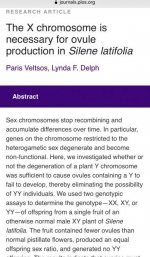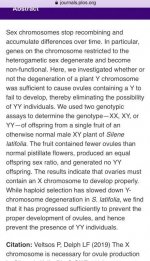To be honest I left this for Sam to explain, as its his thread, but he can jump in and correct any errors he feels I make here.
I just did a couple of PMS explaining this, so I can paste the info in.
Dominant and recessive has nothing to do with how frequently they are passed down, but rather their relationship in the expression.
X and y will be passed from a male at 50:50 ratios, but the dominance of the Y chromosome means that if it is present, the plant will express male flowers and be a male plant. The x is recessive. If two x's are the only sex chromosomes present, then the plant will be female. This assumes there are no mutations to allow the DNA present in the autosome to produce male flowers. The job of the x is to silence the male flower DNA in the autosome, the job of the y is to silence the x and the autosomal female flower dna
DNA for flowers is in the autosome not the sex chromosome. The job of the sex chromosomes are to silence flower production not cause it.
Really not trying to be a dick, its just useful to have it clear.
I just did a couple of PMS explaining this, so I can paste the info in.
Dominant and recessive has nothing to do with how frequently they are passed down, but rather their relationship in the expression.
X and y will be passed from a male at 50:50 ratios, but the dominance of the Y chromosome means that if it is present, the plant will express male flowers and be a male plant. The x is recessive. If two x's are the only sex chromosomes present, then the plant will be female. This assumes there are no mutations to allow the DNA present in the autosome to produce male flowers. The job of the x is to silence the male flower DNA in the autosome, the job of the y is to silence the x and the autosomal female flower dna
DNA for flowers is in the autosome not the sex chromosome. The job of the sex chromosomes are to silence flower production not cause it.
Really not trying to be a dick, its just useful to have it clear.
Last edited:




